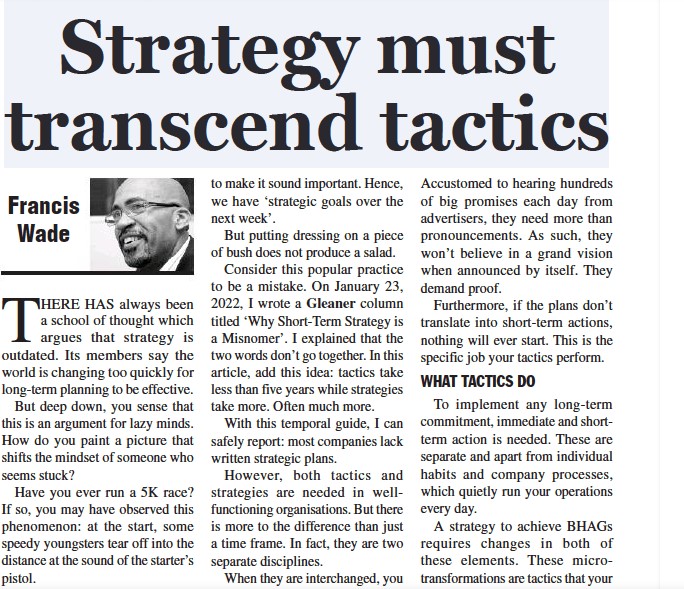In the ever-evolving landscape of business, some voices argue that the concept of strategy is becoming obsolete, overshadowed by the rapid pace of change. Yet, beneath this assertion lies a reluctance to engage in deep, thoughtful planning—a sentiment that betrays a certain intellectual inertia. How can we reshape this perspective, sparking a transformation in those who seem trapped within it?
Imagine participating in a 5k race. At the starting gunshot, you witness young runners dashing forth with an incredible burst of speed. A mile or two later, however, you find them struggling, on the brink of exhaustion, while you maintain a steady jog, passing them by. They fell into a common trap: assuming a long-distance race can be conquered by a series of short sprints.
The truth is, successful long-distance running requires a series of well-informed decisions. Every step carries consequences, and a misstep can lead to failure.
This analogy seamlessly mirrors the distinction between tactical maneuvers and strategic planning in an organizational context. To prevent confusion, businesses must delineate these concepts clearly.
Distinguishing Between Short-Term Tactics and Long-Term Strategy
Modern tendencies have led to the casual labeling of everything as “strategic,” a practice that dilutes its significance. Consider the phrase “strategic goals for the week.” Yet, placing a fancy veneer on a shrub won’t yield a salad.
Challenge this tendency, as I did in a Gleaner column on January 23, 2022, titled “Why Short-Term Strategy is a Misnomer.” I explored the incongruity of coupling these two words. The essence: tactics span a few years, while strategies encompass a much longer horizon. In this article, let’s assume the cutoff point to be five years.
With this test at hand, a stark truth emerges: most companies lack written strategic plans.
Yet, both tactics and strategies remain essential in a thriving organization. However, their demarcation extends beyond time frames. They stand as separate disciplines, and interchanging them can lead to an unsustainable sprint, endangering the future. To avert this, let’s scrutinize their individual roles.
Strategies: The Architects of Transformation
The concept of BHAGs—Big Hairy Audacious Goals—commands attention. Defined by visionaries Jim Collins and Jerry Porras, these goals entail transformative results, forming a roadmap for a company’s metamorphosis. The Sustainable Development Goals set by the UN for 2030 in 2015, and Jamaica’s Vision 2030, forged in 2007, stand as prominent examples. Echoing through history is President Kennedy’s 1961 moonshot declaration, propelling humanity to the lunar surface within a decade.
Strategic plans are purposely designed to realize such audacious visions. But modernity demands them to be credible in new ways. Why?
An attainable plan provides a solid foundation, a platform of trust that validates visionary aspirations. In a world numbed by the barrage of daily promises from advertisers, credibility is paramount. Mere proclamations hold no sway; substance is demanded.
Additionally, the translation of grand plans into immediate actions is pivotal. This is where tactics come into play.
Tactics: The Craftsmen of Incremental Change
Execution of any long-term commitment mandates swift short-term actions. These actions exist independently from ingrained habits and routine, daily processes.
Realizing BHAGs necessitates altering these operational elements. These micro-transformations constitute tactics, to be executed by your team.
However, this is easier said than done. Overcoming inertia to scale these long-term commitments is a formidable task.
Case in point: If a company is perpetually reactive, progress is hard to sustain over years.
Similarly, if an organization’s status quo has endured for eons, kindling enthusiasm for BHAGs seems to be an impossible pursuit.
The crux is that achieving long-term aspirations hinges on tactical modifications, demanding adept change management.
While strategies and tactics are distinct, they must remain united without being confused. This unity is the compass guiding an organization toward its envisioned future.
In summary, the narrative of a road race underscores the vital distinction between strategic vision and tactical maneuvers. By untangling these concepts and skillfully blending them, organizations can chart a course toward their ultimate goals. As you reflect on your organization’s journey, remember, it’s not about doing either the sprint or the jog—it’s about the seamless, synchronized dance between the two that propels you forward.
This article is based on a similar column published in the Jamaica Gleaner. It’s available behind the newspaper’s paywall.

